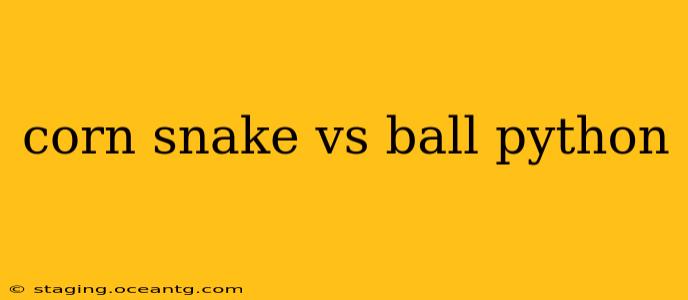Choosing your first snake can be an exciting but daunting task. Two popular choices often top the list: the corn snake and the ball python. Both are relatively docile, making them suitable for beginners, but they have distinct differences that can significantly impact your decision. This comprehensive guide will delve into the key aspects of corn snakes and ball pythons, helping you determine which species is the right fit for your lifestyle and experience level.
Corn Snake vs. Ball Python: Size and Growth
Corn snakes (Pantherophis guttatus) are generally smaller than ball pythons, reaching an average adult length of 3-5 feet. Their growth is relatively rapid, reaching near-adult size within a couple of years.
Ball pythons (Python regius), on the other hand, are more substantial, typically growing to 3-5 feet, though some can reach slightly longer lengths. Their growth is slower than corn snakes, taking longer to reach full adult size.
Corn Snake vs. Ball Python: Temperament and Handling
Both corn snakes and ball pythons are known for their docile nature, making them popular choices for beginners. However, individual personalities can vary. Corn snakes are often described as being more active and curious than ball pythons. Ball pythons, while generally calm, are more prone to stress and may become defensive if handled improperly or too frequently. Gentle and respectful handling is crucial for both species.
Corn Snake vs. Ball Python: Care Requirements
While both are relatively low-maintenance, their care requirements differ slightly.
Housing:
- Corn Snakes: Require a smaller enclosure compared to ball pythons. A 20-gallon long tank is suitable for an adult.
- Ball Pythons: Need a larger enclosure, ideally a 40-gallon breeder tank or larger for an adult.
Temperature and Humidity:
Both species require specific temperature and humidity gradients within their enclosures. Proper temperature and humidity control is crucial for their health and well-being, often achieved through the use of heat lamps, heat mats, and humidity hides. Researching the precise requirements for each species is vital.
Feeding:
- Corn Snakes: Are primarily mouse eaters, with frozen-thawed mice being the preferred feeding method.
- Ball Pythons: Also consume mice, typically frozen-thawed, but may require larger prey items as they grow.
What is the difference between a corn snake and a ball python?
This question highlights the core difference—the species themselves. Beyond the size, temperament, and care requirements already discussed, their appearance is also quite different. Corn snakes exhibit a wide range of colors and patterns, from the classic red and yellow to more unusual morphs. Ball pythons, while also displaying various morphs, typically feature a more subdued coloration.
Are corn snakes good pets?
Yes, corn snakes are excellent pets for beginners due to their docile nature, relatively small size, and relatively simple care requirements. Their variety of colors and patterns also adds to their appeal.
Are ball pythons good pets?
Ball pythons are also good pets, though perhaps slightly more challenging for absolute beginners due to their larger size and slightly more sensitive temperament. Proper research and careful handling are key to successfully keeping a ball python.
Which snake is easier to care for?
Generally, corn snakes are considered easier to care for due to their smaller size, less demanding enclosure requirements, and somewhat more tolerant nature. However, both species are manageable with proper research and dedication.
Which snake is better for a beginner?
For absolute beginners, a corn snake is often the recommended choice. Their ease of care and docile temperament make them ideal for gaining experience in reptile keeping.
Conclusion: Making the Right Choice
The best snake for you depends entirely on your experience level, lifestyle, and commitment. Carefully weigh the pros and cons of each species, considering your available space, time, and resources before making your decision. Thorough research is essential before bringing any reptile into your home. Remember, responsible reptile ownership involves providing proper care, enriching environments, and understanding the species' specific needs.
